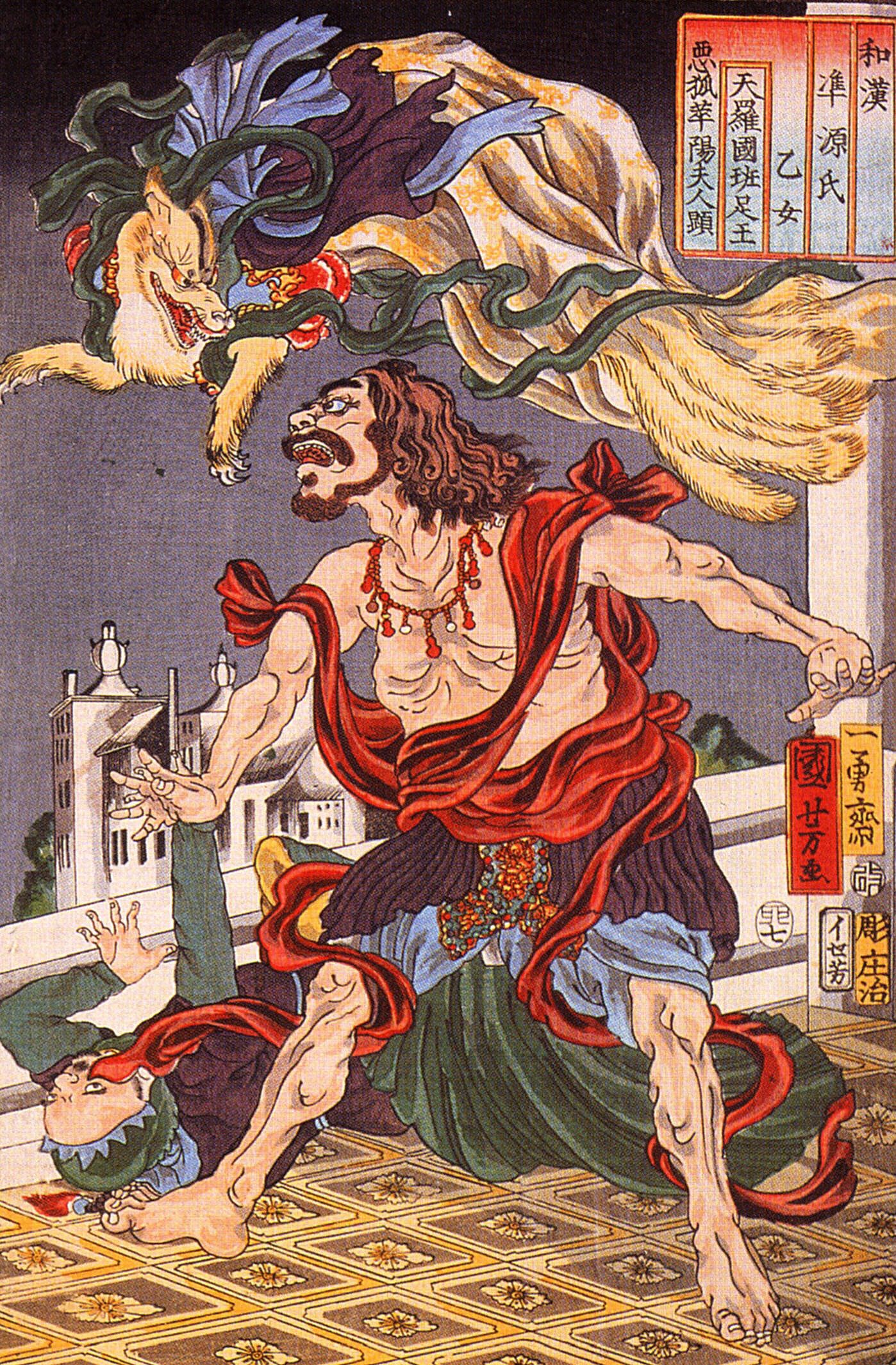|
Gaikotsu Shotenin Honda-san
is a Japanese comedy manga series by Honda, serialized online via '' pixiv Comic'' website between August 2015 and March 2019. It was collected in four ''tankōbon'' volumes by Media Factory. The manga is licensed in North America by Yen Press. An anime television series adaptation by DLE aired from October 8 to December 24, 2018. Plot ''Skull-face Bookseller Honda-san'' is based on a real life experience of the author Honda during her days as a bookstore employee. The story follows the life of the staff while explaining how a bookstore works. Characters ; : :The title character and narrator of the story, Honda is drawn with the appearance of a human skeleton wearing a book store uniform. Honda has been working at the book store for 10 years. Being in charge of foreign comics and art books (which is why the boxes containing her books are usually heavy), she is not good at speaking English and will only deal with one English word she knows when dealing with foreign customers. ... [...More Info...] [...Related Items...] OR: [Wikipedia] [Google] [Baidu] |
Comedy
Comedy is a genre of fiction that consists of discourses or works intended to be humorous or amusing by inducing laughter, especially in theatre, film, stand-up comedy, television, radio, books, or any other entertainment medium. The term originated in ancient Greece: in Athenian democracy, the public opinion of voters was influenced by political satire performed by comic poets in theaters. The theatrical genre of Greek comedy can be described as a dramatic performance pitting two groups, ages, genders, or societies against each other in an amusing '' agon'' or conflict. Northrop Frye depicted these two opposing sides as a "Society of Youth" and a "Society of the Old". A revised view characterizes the essential agon of comedy as a struggle between a relatively powerless youth and the societal conventions posing obstacles to his hopes. In this struggle, the youth then becomes constrained by his lack of social authority, and is left with little choice but to resort to ruses w ... [...More Info...] [...Related Items...] OR: [Wikipedia] [Google] [Baidu] |
Title Character
The title character in a narrative work is one who is named or referred to in the title of the work. In a performed work such as a play or film, the performer who plays the title character is said to have the title role of the piece. The title of the work might consist solely of the title character's name – such as ''Michael Collins'' or ''Othello'' – or be a longer phrase or sentence – such as ''The Autobiography of Malcolm X'', '' Alice in Wonderland'' or ''The Adventures of Tom Sawyer''. The title character is commonly – but not necessarily – the protagonist of the story. Narrative works routinely do not have a title character, and there is some ambiguity in what qualifies as one. Examples in various media include Figaro in the opera ''The Marriage of Figaro'', Giselle in the ballet of the same name, the Doctor in the TV series ''Doctor Who'', Harry Potter in the series of novels and films, Romeo Montague and Juliet Capulet in the play ''Romeo and Juliet'', Amos Jon ... [...More Info...] [...Related Items...] OR: [Wikipedia] [Google] [Baidu] |
Kazutomi Yamamoto
is a Japanese voice actor and singer affiliated with Production Ace. In 2013, he won the 7th Seiyu Awards as the Best Rookie actors along with Nobunaga Shimazaki. Voice acting roles Anime television series ;2009 *''Seitokai no Ichizon'' as Yoshiki Nakameguro ;2010 *''Mitsudomoe'' as Yuudai Chiba ;2011 *''Is This a Zombie?'' as Fan (episode 12) *'' Sekai Ichi Hatsukoi'' as Company Employee (episode 7), Moving Contractor (episode 2) *''Nichijou'' as Tsuyoshi Nakanojō *'' Mitsudomoe Zōryōchū!'' as Yuudai Chiba ;2012 *'' Another'' as Yuuya Mochizuki *''Mobile Suit Gundam AGE'' as Kio Asuno ;2013 *''Noucome'' as Touya Yoshiwara *''Majestic Prince'' as Claine *'' Genshiken: Second Generation'' as Kenjiro Hato (as a male) *''Blood Lad'' as Mimic Yoshida *'' Makai Ouji: Devils and Realist'' as Amon ;2014 *''Yona of the Dawn'' as Min-su *''Gugure! Kokkuri-san'' as Yamamoto-kun *''The Seven Deadly Sins'' as Young Gilthunder *''Haikyū!!'' as Mori (episode 1) *''Chaika - The Cof ... [...More Info...] [...Related Items...] OR: [Wikipedia] [Google] [Baidu] |
Noh Mask
is a major form of classical Japanese dance-drama that has been performed since the 14th century. Developed by Kan'ami and his son Zeami, it is the oldest major theatre art that is still regularly performed today. Although the terms Noh and '' nōgaku'' are sometimes used interchangeably, ''nōgaku'' encompasses both Noh and ''kyōgen''. Traditionally, a full ''nōgaku'' program included several Noh plays with comedic ''kyōgen'' plays in between; an abbreviated program of two Noh plays with one ''kyōgen'' piece has become common today. Optionally, the ritual performance ''Okina'' may be presented in the very beginning of ''nōgaku'' presentation. Noh is often based on tales from traditional literature with a supernatural being transformed into human form as a hero narrating a story. Noh integrates masks, costumes and various props in a dance-based performance, requiring highly trained actors and musicians. Emotions are primarily conveyed by stylized conventional gestures whi ... [...More Info...] [...Related Items...] OR: [Wikipedia] [Google] [Baidu] |
Kitsune
In Japanese folklore, , are foxes that possess paranormal abilities that increase as they get older and wiser. According to ''yōkai'' folklore, all foxes have the ability to shapeshift into human form. While some folktales speak of employing this ability to trick others—as foxes in folklore often do—other stories portray them as faithful guardians, friends, and lovers. Foxes and humans lived close together in ancient Japan; this companionship gave rise to legends about the creatures. have become closely associated with Inari, a Shinto or spirit, and serve as its messengers. This role has reinforced the fox's supernatural significance. The more tails a has—they may have as many as nine—the older, wiser, and more powerful it is. Because of their potential power and influence, some people make sacrifices to them as to a deity. Conversely foxes were often seen as " witch animals", especially during the Edo period (1603–1867), and were thought of as goblins who could ... [...More Info...] [...Related Items...] OR: [Wikipedia] [Google] [Baidu] |
Kodansha
is a Japanese privately-held publishing company headquartered in Bunkyō, Tokyo. Kodansha is the largest Japanese publishing company, and it produces the manga magazines ''Nakayoshi'', ''Afternoon'', ''Evening'', ''Weekly Shōnen Magazine'' and ''Bessatsu Shōnen Magazine'', as well as the more literary magazines ''Gunzō'', ''Shūkan Gendai'', and the Japanese dictionary ''Nihongo Daijiten''. Kodansha was founded by Seiji Noma in 1910, and members of his family continue as its owners either directly or through the Noma Cultural Foundation. History Seiji Noma founded Kodansha in 1910 as a spin-off of the ''Dai-Nippon Yūbenkai'' (, "Greater Japan Oratorical Society") and produced the literary magazine ''Yūben'' () as its first publication. The name ''Kodansha'' (taken from ''Kōdan Club'' (), a now-defunct magazine published by the company) originated in 1911 when the publisher formally merged with the ''Dai-Nippon Yūbenkai''. The company has used its current legal name since ... [...More Info...] [...Related Items...] OR: [Wikipedia] [Google] [Baidu] |
Shizuka Itou
is a feminine Japanese given name. Possible writings Shizuka can be written using different kanji characters and can mean: *, "quiet/calm" *, "quiet/calm, flower" *, "quiet/calm, fragrance" *, "quiet/calm, flower" *, "quiet/calm, excellent" *, "quiet/calm, summer". The name can also be written in hiragana or katakana. People with the name * , Taiwanese actress * , Japanese voice actress * , Japanese figure skater * , also known as Lady Shizuka, one of the most famous women in Japanese history and literature * , Japanese voice actress * , Japanese novelist and lyricist * , Japanese actress and dancer * , Japanese voice actress * , Japanese voice actress * , Japanese voice actress * , Japanese politician * , Japanese singer * , Japanese ball-jointed doll maker and musician * , Japanese gravure idol and actress *, Japanese table tennis player * , motorcycle racer * , Japanese actress, gravure idol, and writer * Shizuka Sugiyama (born 1987), Japanese mixed martial arts fighter * , ba ... [...More Info...] [...Related Items...] OR: [Wikipedia] [Google] [Baidu] |
Shueisha
(lit. "Gathering of Intellect Publishing Co., Ltd.") is a Japanese company headquartered in Chiyoda, Tokyo, Japan. The company was established in 1925 as the entertainment-related publishing division of Japanese publisher Shogakukan. The following year, Shueisha became a separate, independent company. Manga magazines published by Shueisha include the ''Jump'' magazine line, which includes shonen magazines ''Weekly Shōnen Jump'', ''Jump SQ'', and ''V Jump'', and seinen magazines ''Weekly Young Jump'', ''Grand Jump'' and ''Ultra Jump''. They also publish other magazines, including ''Non-no''. Shueisha, along with Shogakukan, owns Viz Media, which publishes manga from all three companies in North America. History In 1925, Shueisha was created by major publishing company Shogakukan (founded in 1922). became the first novel published by Shueisha in collaboration with Shogakukan—the temporary home of Shueisha. In 1927, two novels titled ''Danshi Ehon'', and ''Joshi Ehon'' we ... [...More Info...] [...Related Items...] OR: [Wikipedia] [Google] [Baidu] |
Kimiko Saitō
is a Japanese voice actress and narrator from Nagano Prefecture. She is affiliated with Aoni Production. Some of her major roles are Rem in ''Death Note'', Sister in ''Eden of the East'', Chieko in ''Princess Jellyfish'', Hiroko in ''Blue Drop'' and Big Madam in ''Tokyo Ghoul''. Filmography Television animation *''One Piece'' (1999), Gyoro, Boa Marigold, Catarina Devon, Acilia, Uhoricia, Charlotte Mondee *'' Ultimate Muscle: The Kinnikuman Legacy'' (2002), Helga, Suzy *''Area 88'' (2004), Alicia *''Kyo Kara Maoh!'' (2004), Tzo *''Tweeny Witches'', Biris *'' Basilisk: The Kouga Ninja Scrolls'' (2005), Ofuku/Lady Kasuga *'' Ayakashi'' (2006), Obi *''Yu-Gi-Oh! 5D's'' (2008), Martha *'' Welcome to the N.H.K.'' (2006), Misaki's Aunt *''Death Note'' (2006), Rem *''Kekkaishi'' (2006), Fuzuki *'' Blue Drop: Tenshitachi no Gikyoku'' (2007), Hiroko Funatsumaru *'' Higashi no Eden'' (2009), Sis *''Seikon no Qwaser'' (2010), Big Ma'am *'' Bakugan: Gundalian Invaders'' (2010), Kazarina, Avior ... [...More Info...] [...Related Items...] OR: [Wikipedia] [Google] [Baidu] |
Eri Kitamura
is a Japanese voice actress and singer. She was previously affiliated with Early Wing, but is now a freelancer. She is known for voicing prominent roles in anime such as and Sayaka Miki in '' Puella Magi Madoka Magica'', Saya Otonashi in ''Blood+'', Keqing in ''Genshin Impact'', Shizuku in ''New Game!'', Darjeeling in ''Girls und Panzer'', Uni/Black Sister in ''Hyperdimension Neptunia'', Ranko Honjō in ''My First Girlfriend Is a Gal'', Yuka Mochida in ''Corpse Party'', Bea in '' Pokémon: Twilight Wings'', and Miki Aono/Cure Berry in ''Fresh Pretty Cure!''. In addition, she provided the voice for Vocaloid CUL-REBIRTH. She is known to be an amateur manga artist in Japan in her spare time. Filmography Television animation Original video animation (OVA) *'' Aruvu Rezuru: Kikaijikake no Yōseitachi'' – Shiki Mikage *''Durarara!!'' – Mairu Orihara *'' Fairy Tail: Welcome to Fairy Hills!!'' – Cana Alberona, Aquarius *''ICE'' – Mint *''Indian Summer'' (2007, OVA) – Yui * ... [...More Info...] [...Related Items...] OR: [Wikipedia] [Google] [Baidu] |
Yonkoma
, a comic strip format, generally consists of gag comic strips within four panels of equal size ordered from top to bottom. They also sometimes run right-to-left horizontally or use a hybrid 2×2 style, depending on the layout requirements of the publication in which they appear. Although the word ''yonkoma'' comes from Japanese, the style also exists outside Japan in other Asian countries as well as in the English-speaking market, particularly in mid-20th century United States strips, where ''Peanuts'' popularized the format. Origin Rakuten Kitazawa (who wrote under the name Yasuji Kitazawa) produced the first ''yonkoma'' in 1902. Entitled ''Jiji Manga'', it was thought to have been influenced by the works of Frank Arthur Nankivell and of Frederick Burr Opper.Carolin Fischer,'Mangaka',Unknown date of publication, "http://www.mangaka.co.uk/?page=yonkoma", 2009-10-29 Structure Traditionally, ''yonkoma'' follow a structure known as ''kishōtenketsu''. This word is a compound fo ... [...More Info...] [...Related Items...] OR: [Wikipedia] [Google] [Baidu] |


.jpg)
